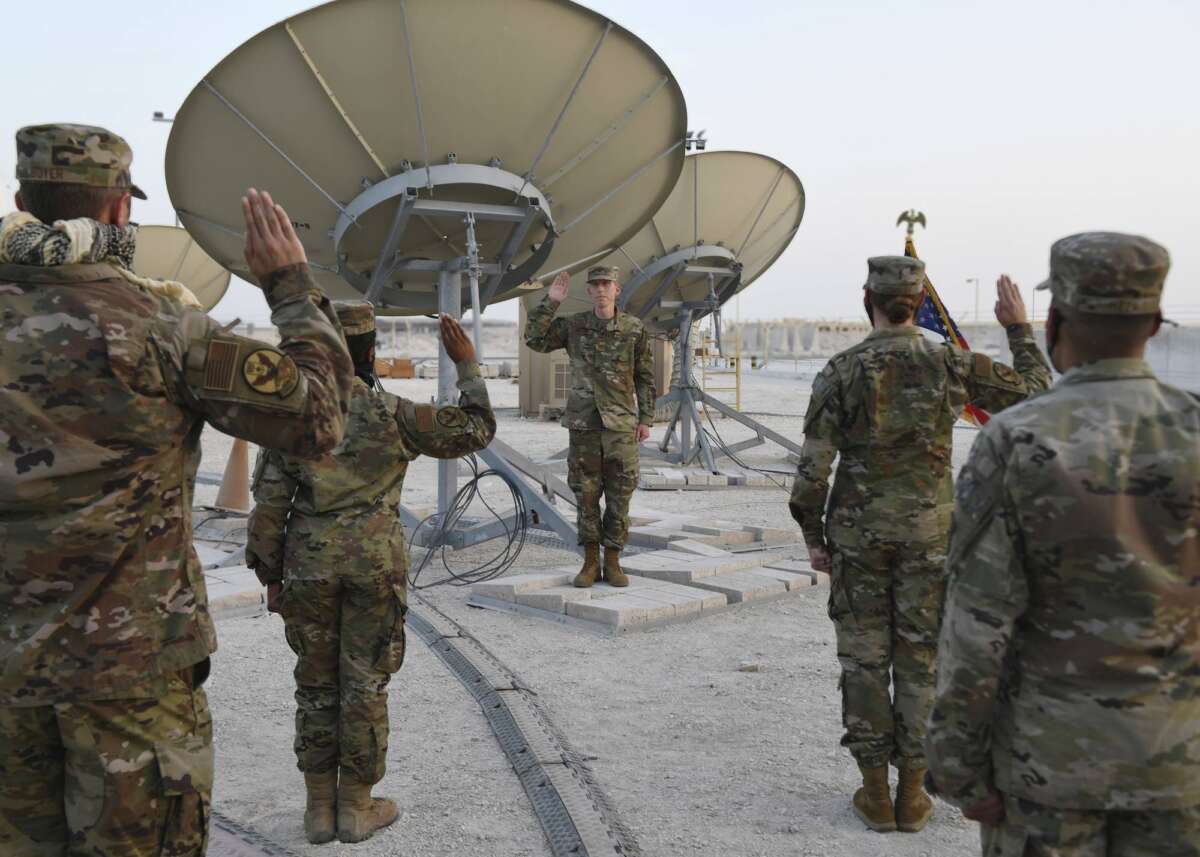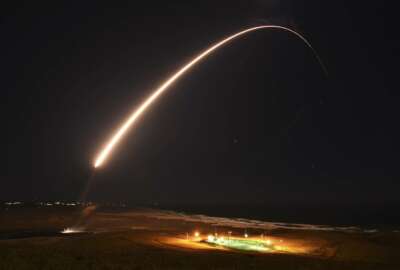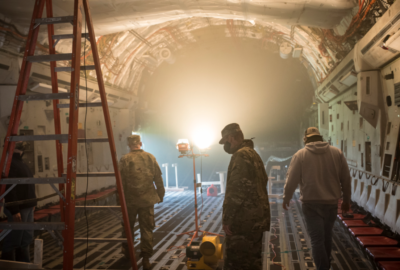
Air Force innovator’s new job takes him to Space Force
Andrew Williams produced a string of technological innovations while working for the Air Force. Now he's been promoted to deputy technology executive officer for...
Best listening experience is on Chrome, Firefox or Safari. Subscribe to Federal Drive’s daily audio interviews on Apple Podcasts or PodcastOne.
Andrew Williams produced a string of technological innovations while working for the Air Force. Now he’s been promoted to deputy technology executive officer for Space Science and Technology. That means he’ll work directly on the Space Force mission. Williams joined the Federal Drive with Tom Temin with details.
Interview transcript:
Tom Temin: Dr. Williams. Good to have you on.
Andrew Williams: Thanks. We appreciate it.
Tom Temin: All right, tell us first of all, it seems like this job that you have, by title, signifies the somewhat bifurcation of the lab into serving two separate forces now — the Space Force and the Air Force. Fair way to put it?
Andrew Williams: Actually really a unification of the two. When Space Force started to stand up, what we thought through was whether or not it needed to have its own lab. And when we started looking into the details, we determined that there was a lot of multi-domain aspects to the technologies that we’re developing — things like cyber quantum autonomy, artificial intelligence. All of those things have a multi-domain aspect to them that are both applicable to air and space, especially in the basic research and early Applied Research phases. And so what we didn’t want to do is create two labs that split those resources up, especially funding-wise, and laboratory research-wise. And so it made a lot of sense to keep the lab together to form a single lab with one lab supporting two services, with the deputy TEO for space as the position that’s responsible for integrating and executing the space pieces of the portfolio across the AFRL enterprise.
Tom Temin: And the things that the space and non-space, let’s say, I mean, airplanes come close to space, but they’re not in space. So that’s the fundamental differences, you know, a few 100,000 feet of altitude, I guess. But cyber, you mentioned autonomy, artificial intelligence, those types of things that are really in common, regardless of the domain, whether there’s air around it or not.
Andrew Williams: Yeah, a lot of the fundamental aspects of those technologies are applicable to both/ Autonomy and concepts and artificial intelligence, the basic concept of how we do that, the algorithms that are used are similar. iI’s just the hardware that we put them on is different, whether it’s on an aircraft system or a spacecraft system. And when we advanced them to the 6.3 regime of funding, and more advanced technology development, there are differences between the domains that start to become apparent. But when you’re doing the fundamental research, there really are multi-domain aspects that are applicable to both.
Tom Temin: And what are the services telling you their requirements are what’s driving the research agenda? Fundamentally,
Andrew Williams: We have a very robust engagement with the Space Force where we have an annual process. We develop techniques with the field commands that were set up under Space Force. They give us a priority of what those functions are, really focused on how do we improve resiliency of the Space Systems. How do we provide better capabilities to the warfighter? And how do we improve the overall cost and functionality dynamic and cost benefit of the space systems to ensure that they’re available to the joint fight?
Tom Temin: And there’s some urgency coming into this as the domain of space increasingly is contested as a military domain. And we see other nations deploying capabilities that are kind of scary for a place that’s been peaceful until now.
Andrew Williams: That’s very true. The fundamental thing that we have to do is really accelerate. That’s the focus of everything. When I started my career at AFRL, it was in an uncontested domain. There was not a lot of congestion, but the complexity has really ramped up. There’s an acceleration of the threat. There’s an acceleration of technology in general. And there has been a huge increase in the complexity of the environment with commercial, with allied. It’s not just government entities like the U.S. government that are dominating. There’s a lot more complexity to it. Everything is accelerating, and we have to accelerate the science and technology to keep up with it.
Tom Temin: Yeah, the deployment of these swarms of CubeSats at low Earth orbit and so forth by commercial entities. And increasingly, the government is looking at also launching these — I call them CubeSats — but the small satellites that are about the size of a breadbox, and I guess you can string three of them together and you have a three CubeSat and so forth. That’s a big changing factor there, isn’t it?
Andrew Williams: It is. There’s a lot of challenges because you have an increase in number. They’re smaller, they’re harder to keep track of. So there are space domain awareness challenges. It used to be that we had to track a lot of large things generally in geosynchronous orbit in low Earth orbit. But with cube sats and with other things coming into play, and the increase of the numbers of constellations, it creates a huge challenge in complexity for domain awareness in tracking the objects and understanding what they’re actually doing.
Tom Temin: Well, at least they’re cheaper than the big ones. We’re speaking with Dr. Andrew Williams. He’s deputy technology executive for space science and technology at the Air Force Research Laboratory. And tell us about your own background. You’ve got a pretty good string of inventions and research results of your own that you bring to this.
Andrew Williams: I started at AFRL about 18 years ago. I spent a year in industry and then started as a palace acquire intern with the Air Force. So I did a year of on the job training; they paid to get my master’s degree, and then I came back. After that I started my career really focused on thermal technologies, flew a lot of interesting flight experiments on the International Space Station. I flew experiments on the NASA microgravity aircraft, aka the vomit comet.
Tom Temin: Yes, indeed.
Andrew Williams: It was lot of fun, it was a blast. But the technologies that we were developing were really focused at things like rollout solar arrays to provide better power to spacecraft. We were looking at thermal technologies. We recently just had a huge transition with our oscillating heat pipe technology, where we’re actually flying it on an operational maxar commercial, the Sirius XM satellite. So that is a technology that we started in the lab about a decade ago, and is now transitioning into actual operational capabilities.
Tom Temin: What is an oscillating heat pipe? It could be a lot of things.
Andrew Williams: I was afraid you’d ask that, because it’s kind of a complex technology. But it is a way to transfer heat from the electronics box where the heat is generated to the radiator where it’s actually rejected to space. The biggest difference between the air and space domain is that space is a vacuum. So there’s no easy way to reject heat via convection and things like that, so we actually have to reject the heat. The oscillating heat pipe is a flat plate with the serpentine channel. And there’s some interesting thermodynamic aspects that allow us to get it to work. But it transfers heat very efficiently and very effectively.
Tom Temin: So it’s kind of like a flying heat sink with some real high tech properties.
Andrew Williams: It is, and it’s a significant improvement over the state of the art of what we currently have. It really is what we believe going to usher in a fourth generation of spacecraft thermal control.
Tom Temin: Alright, and you’re mentioning a few other things you’ve worked on.
Andrew Williams: So I started as the thermal lead. I started working as a program manager after that in the structures program, so deployable structures. That’s where we did things like the rollout solar array, but we also did RF antennas. Thermal technologies are in there, and then fabrication technologies — composite materials, 3D printing, all of those things were within the portfolio. And so that really helped me understand the complexities of space systems, because the structure and the thermal subsystems touch all aspects of the spacecraft, I developed a real deep understanding of satellite design, through those positions.
Tom Temin: And as deputy technology executive for space science and technology, will you still be able to get your hands on real research? Or do you have to just supervise everybody else and read spreadsheets?
Andrew Williams: I think it’s going to be a lot of meetings, a lot of interactions with people. I don’t think I’m going to get my hands dirty in the lab as much as I would like. But hopefully, I can still continue to do that.
Tom Temin: And what’s kept you in the federal government? I mean, there’s so many big, well-funded companies doing aerospace and aerospace research out there in the private sector. Ever occur to you to go, well, let’s triple this and get to work for XYZ company?
Andrew Williams: I’ve thought through that, but I really like the aspects of working for the government. There is a patriotic aspect to it. But it’s also the aspect I like seeing what is going on across all industry, all academia, seeing where the interconnections are, seeing how I can put together programs and build teams in order to go after challenging problems. And I don’t think I would have that ability in the private sector. I can’t see across the entire create space. And so creating those networks, almost putting that puzzle together of the interlocking pieces to go after real capability is really what I love about working for the government and being at AFRL.
Tom Temin: You might say it gives you a satellite view of the whole thing.
Andrew Williams: That’s fair, yeah.
Tom Temin: All right. Dr. Andrew Williams is deputy technology executive for space science and technology at the Air Force Research Laboratory. Thanks so much for joining me.
Andrew Williams: Appreciate it. Thank you.
Copyright © 2025 Federal News Network. All rights reserved. This website is not intended for users located within the European Economic Area.
Tom Temin is host of the Federal Drive and has been providing insight on federal technology and management issues for more than 30 years.
Follow @tteminWFED
Related Stories





